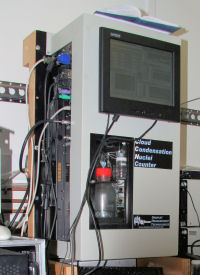Cloud Condensation Nucleus Counter

Instrument Description
A Cloud Condensation Nucleus Counter (CCNc) is an instrument designed to count the number of particles which will activate to form cloud droplets at a specific supersaturation. A particle’s ability to form a cloud droplet is important in terms of radiative effects and removal processes, and depends on its size and chemical composition. The CCNc instruments operated by the Centre for Atmospheric Science are continuous flow thermal gradient instruments of the Roberts and Nenes (2005) design manufactured by Droplet Measurement Technologies (DMT). The operation of the DMT instrument is characterised by Lance et al. 2006. The principle of operation of these instruments is based on the fact that diffusion of water vapour in air is faster than diffusion of heat. This is because of the low concentration and molar mass of water vapor with respect to air. Water molecules are lighter than N2 and O2, and so diffuse more quickly in air than
heat because diffusion of heat is governed by the collisions between slower (on average) air molecules.
The CCNc instrument is made up of a cylindrical column 0.5m long. The inner walls of the column are constructed of a porous material which is kept wet. A temperature gradient is established along the length of the column, with temperature increasing in the direction of air flow. As air flows through the column both heat and water vapour diffuse from the walls to the centre, since thermal diffusion lags vapour diffusion a constant supersaturation is established at the centre of the column. This supersaturation is dependant on the temperature gradient, total air flow and absolute pressure in the chamber. In the DMT instrument supersaturation is controlled by changing the temperature gradient, the column having three actively controlled temperature zones, allowing a change in supersaturation to take place in about 30s. Airflow through the column is made up of the sample, surrounded by a particle free humidified sheath flow, which acts to hold the sample flow in the centre of the column in the region of maximum supersaturation. The DMT instrument is typically operated with a 10:1 sheath – sample flow ratio with the total flow in the range 400-900cc/min. The instrument is capable of operating at supersaturations between 0.1 and 2% which is representative of supersaturations experienced in the atmosphere for a range of different cloud types. Currently a method of rapidly scanning supersaturation by varying the total flow rate is under development.
Particles exiting at the bottom of the column are counted and sized using a specially designed optical particle counter which operates in the size range 0.75-10 microns with 20 size bins. A size distribution is produced once per second.
Method of Deployment
Within the Centre for Atmospheric Science, the CCNc is normally operated in conjunction with a DMPS instrument in order to provide CCN activated fraction as a function of particle size and supersaturation. A sigmoid fit is applied to the activated fraction data for a given particle size to determine critical supersaturation (supersaturation required to activate 50% of particles) for that size. In this set up the CCNc samples from the output of a DMA in parallel with a CPC usually a TSI 3010. The CCNc instrument is set up to scan over a range of supersaturations with 10 minutes being spent on each supersaturation. During each 10 minute interval the DMPS steps the DMA through a range of output particle sizes. Activated fraction is determined by comparing the number of particles >2 microns measured by the CCNc with the total particles counted by the CPC. Over an hour a full set of activated fractions as a function of size and supersaturation is obtained.
Calibration
Field calibration of the CCNc is performed by introducing particles of known size and chemical composition into the instrument and determining the critical supersaturation as described above. This is then compared with the results from an aerosol activation model. Typically ammonium sulphate and sodium chloride particles are used for calibration purposes.
References
Lance, S., Medina, J., Smith, J.N., Nenes, A. Mapping the Operation of the DMT Continuous Flow CCN Counter, Aeros.Sci.Tech., 40, 242-254, 2006.
Roberts, G., and Nenes, A. A Continuous-Flow Streamwise Thermal-Gradient CCN Chamber for Atmospheric Measurements, Aerosol Science and Technology, 39, 206–221, 2005.